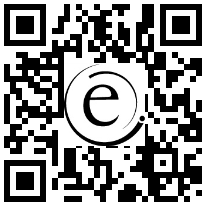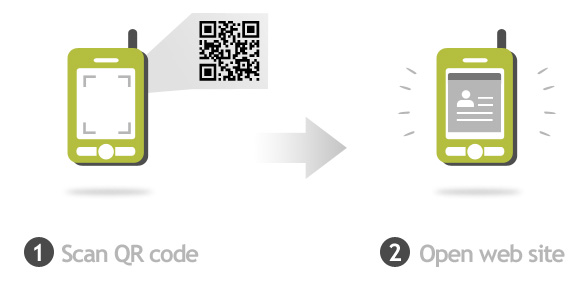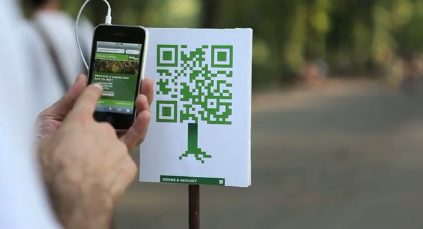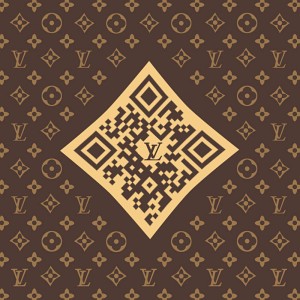If you were in Austin, TX during the 2011 SXSW conference, you were more than likely bombarded with the hundreds of QR codes all over town, from magazine ads to bumper stickers, to guitar cases, to cocktail napkins. It caused lots of people to start talking about the usage of QR codes and just how beneficial they really are for marketing and advertising. Some people have great things to say about them and some people, (Even a few of my colleagues) aren’t too convinced they are worth the time. So let’s talk about QR codes and see what all the fuss is about.
What is a QR Code?
 First of all, the QR Code is nothing new. It was originally created by the Toyota subsidiary Denso-Wave in 1994 and has been commonly used in Japan since then, although it’s taken a little time to garner a following here in the US. So what is it exactly? A QR code (short for Quick Response) is a specific matrix barcode (or two-dimensional code), readable by dedicated QR barcode readers and smart camera phones. It consists of black modules arranged in a square pattern on a white background, (And can sometimes be modified to include a logo in the center of it). The information encoded can be text, URL or other data and can be decoded or read by any specific QR code scanner or smart phone with a camera and a QR code reader application. The code can then push a line of text, add a vCard to a mobile device or more often push a URL to open a specific web page or link.
First of all, the QR Code is nothing new. It was originally created by the Toyota subsidiary Denso-Wave in 1994 and has been commonly used in Japan since then, although it’s taken a little time to garner a following here in the US. So what is it exactly? A QR code (short for Quick Response) is a specific matrix barcode (or two-dimensional code), readable by dedicated QR barcode readers and smart camera phones. It consists of black modules arranged in a square pattern on a white background, (And can sometimes be modified to include a logo in the center of it). The information encoded can be text, URL or other data and can be decoded or read by any specific QR code scanner or smart phone with a camera and a QR code reader application. The code can then push a line of text, add a vCard to a mobile device or more often push a URL to open a specific web page or link.

How can a QR Code benefit your marketing and advertising efforts?
While QR codes were initially used for tracking parts in vehicle manufacturing, they have quickly become a marketer’s favorite tool by allowing advertisers to embed QR codes in almost any form of print or online materials that have an immediate call to action available to their target market. This call to action can be a simple coupon code you pass to your reader base if they scan it, or it can go to an online landing page with a special campaign promotion just for those readers that took the time to scan your code. You can also point them to an online Google map of your location to make it easy for them to get directions to you right from their mobile device. Or you can have a special presentation or content waiting for the anxious reader scanning your code to enrich their media experience. Many magazines like Road & Track are using QR codes on print ads to push people to rich media and videos of bonus material that could not normally be provided over traditional media. The possibilities of where you send someone with a QR Code are limitless!
For an awesome example of some really stellar creativity pushing the bounds for user engagement and QR Code usage, take a look at the WorldPark project for New York City’s Central Park:

http://www.youtube.com/watch?v=7OCyfV_k2_g
How much does a QR Code cost?
That’s the beauty, a QR Code is FREE to generate and use. You can easily get your own QR code from hundreds of places on the Internet, or you can use a URL shortening service like bit.ly or goo.gl to create your shortened URL and it will provide you with the associated QR code to go with it for no charge at all. You can embed these into your promotional materials, business cards, company letterhead, print advertising and merchandise. Then you can track scans of the code from any web browser.
While most marketers are concerned with trying to find ways to quantify results and show ROI for their advertising endeavors, QR codes have provided a way for you to track who scanned your QR code with up-to-the-minute results. And it eliminates a barrier to taking action by making it so easy to scan as opposed to hoping someone will email you, type in your URL in a browser window or God forbid, actually pick up the phone to make a call to you!
 Custom QR Codes
Custom QR Codes
Many companies are even creating custom designed QR codes to better fit into their brand. And while this venture can take a little more time and come with a fee, it does give you options for customizing what some are calling the ugly square bar code in favor of a more aesthetically pleasing code that will show you take your QR codes and branding very seriously.
So what’s the QR Code verdict?
Many people have argued that QR Codes rely too much on the use of smart phone technology or being available to only those target segments that are more “wired” to the latest technology trends. Well this is absolutely true. But if you consider the fact that a QR code costs nothing to implement into an existing print ad, while allowing an immediate action point for the user and providing you with a means of tracking response rates, it’s hard to deny it’s potential and will likely have a secured place in today’s advertising. If you include it and no one ever uses it, you’ve lost nothing. But I think you’ll find that QR codes will give marketers new and exciting opportunities to engage their audience and provide exciting content in ways not previously possible through traditional media.
Have you seen a great example of QR Codes in advertising, point us to some links and share them with our reader base!
References:
-FINAL(01-00)-White&Blue-01.svg)




